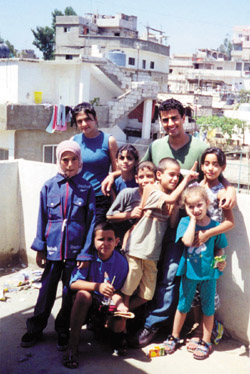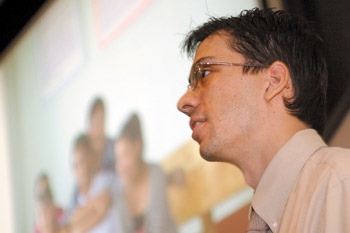
Samer Jaber stands with many of the children he helped this summer at a Palestinian refugee camp. Jaber and Jose Hagan shared their stories of working abroad with fellow VUSM students and faculty.
VUSM students share experiences, love for work abroad

Jose Hagan talks about his experiences in Mongolia. (photo by Dana Johnson)
Samer Jaber, a second-year Vanderbilt University School of Medicine student, ended last summer’s work at a Palestinian refugee camp and a Beirut hospital with conflicting feelings.
He was glad that he went, but sorry he hadn’t been able to do more.
“It reminded me how lucky all of us really are,” Jaber told a group of medical students and faculty who came to hear about the experiences of Jaber and Jose Hagan, both second-year VUSM students who worked abroad over the summer. “I was struck by the kindness of people while I was there. They had so little, but were always so kind. It was probably the best experience I ever had.”
The students, who received money from VUMC’s overall fund for their trips, shared their experiences during a forum sponsored by the VUSM International Committee on Medical Educational Experiences.
Jaber and two other international students from different institutions spent time at Bourj al Barajneh, a refugee camp located just south of Beirut, Lebanon. About 1.4 million Palestinian refugees live in 27 camps in the West Bank, Jordan, Lebanon and Syria. Bourj al Barajneh is located about 10 miles from downtown Beirut, known for its extravagant nightlife and an $8 cup of coffee. At Bourj al Barajneh, the average family home is about 400 square feet, with as many as eight people living together in some homes. The camp has been around for about 50 years, and many families have two generations living together. About 20,000 people live in one square kilometer (about the size of 18 football fields).
There is no water filtration and no sanitation in the camp, so garbage sits on the streets, Jaber said.
“The taxi driver refused to take me within 200 yards of the camp,” Jaber said. “I’ll never forget the smell when I walked in the first day.”
Jaber mostly worked with children at the camp, teaching English and health to the children in the camp. “We would play games with the kids, we’d do anything they wanted us to do. The kids just loved it,” he said. “We also bought a cow heart, lung and liver for dissection. They were typical kids and most of the time, you wouldn’t think they had any problems.”
Jaber also worked in the United Nations-based hospital, taking histories, hooking up IV’s and EKG’s and drawing blood.
Jaber said he was particularly touched by Nadia, a young girl at the camp, who didn’t want to be in a group photograph one afternoon with him. She said she didn’t feel well and that she hadn’t eaten breakfast. When asked, she told him she hadn’t eaten lunch either. Jaber found out that her family had no food in their home.
“You could get a bagel pizza and a drink for about 30 cents at the camp,” Jaber said. “But she couldn’t afford that. I was absolutely devastated. To me, 30 cents is nothing.” From that point on, Jaber bought her lunch and dinner.
When it was time to leave, Jaber left with one regret.
“I’d like to go back with more skills. I wish I could have done more.”
Jose Hagan spent last summer in Mongolia, studying the prevalence of sexually transmitted diseases and HIV in female commercial sex workers. He was based in Ulaanbaatar, Mongolia, a poverty-stricken city, located between China and Russia.
“It was a very fantastic experience for me,” Hagan said. “The area is in between two countries with tremendous HIV populations, yet Mongolia has only had three reported cases. There are, however, many reported cases of STD’s.
“I was there to help assess the prevalence of HIV and STD’s and provide free treatment for STD’s. I wanted to thoroughly understand the commercial sex industry. They’re a very high risk group.”
Hagan said his work was not received well by male pimps, but female pimps actually helped Hagan and his group. “They understood the importance of getting their women tested and treated if necessary.”
Sometimes the testing had to be performed in the most unusual places.
“Most commercial sex happens in train stations, but we couldn’t persuade the women to leave and be tested at a hospital,” Hagan said. “They would lose a lot of money, so we commandeered a ticket booth and did our testing there.”
In some locations children are even active in the commercial sex industry, Hagan said. “They have sex because they need to buy food. It’s a very sad situation.”
Hagan said most women charged $5 to $15 for sexual transactions. About 60 percent reported using condoms, but Hagan said he thought the percentage was actually much lower. In 182 exams, 43.5 percent tested positive for syphilis and 71.2 percent had some STD. About 18 percent tested positive for multiple STD’s. Those who charged less had more disease, as well as those who began having commercial sex at a younger age.
One of the most surprising findings was that there was no HIV in the women who were tested. The group tried to test women in bars and strip clubs that were frequented by Russian and Chinese men, since HIV is so prevalent in those countries.
“I don’t know what to say about the fact that we found no HIV,” Hagan said. “We expected to find some HIV, but once it comes, it will spread very quickly.”
Hagan said when there was no more money left for testing, it was difficult not to counsel and offer treatment to the women he saw on the streets.
“I made a lot of good relationships with people. It was an incredibly meaningful experience,” he told the students. “International work, in general, is something you should consider.”













